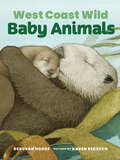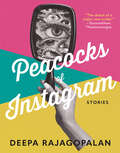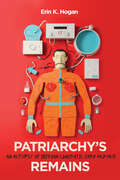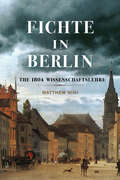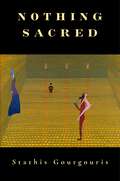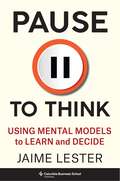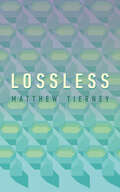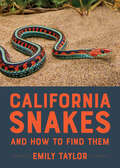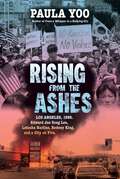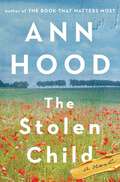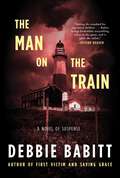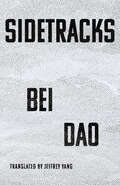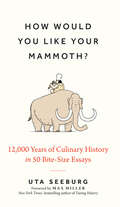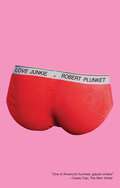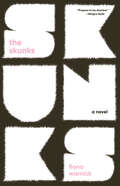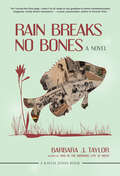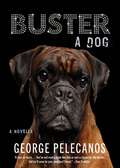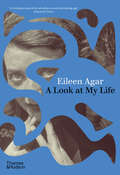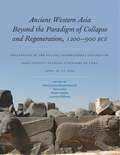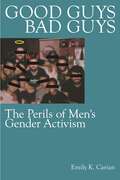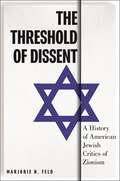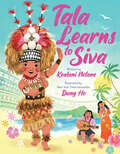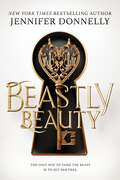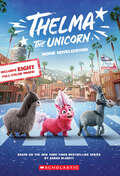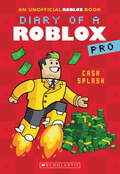- Table View
- List View
West Coast Wild Baby Animals (West Coast Wild)
by Deborah HodgeMeet the wild baby animals of the Pacific west coast! Wolf pups, bear cubs, whale calves and eaglets are thriving in the ancient rainforest, rugged beach and majestic ocean of the Pacific west coast. This sweet introduction to baby animal names and behaviours, with gorgeous watercolor scenes, will delight toddlers and babies everywhere! Key Text Features illustrations
Peacocks of Instagram: Stories
by Deepa RajagopalanEngrossing, witty yet devastating stories about diasporic Indians that deftly question what it means to be safe, to survive, and to call a place home. An underappreciated coffee shop server haunted by her past attracts thousands of followers on social media with her peacock jewellery. A hotel housekeeper up against a world of gender and class inequity quietly gets revenge on her chauvinist boss. And a foster child, orphaned in an accident directly attributable to climate change, brings down her foster father, an oil lobbyist, in spectacular fashion. With an intense awareness of privilege and the lack of it, the fourteen stunning stories in Peacocks of Instagram explore what it means to be safe, to survive, and to call a place home.
Patriarchy’s Remains: An Autopsy of Iberian Cinematic Dark Humour (McGill-Queen's Iberian and Latin American Cultures Series #8)
by Erin K. HoganSomething is rotten in the state of Spain. The uninterred corpse of a patriarchal figure populates the visual landscapes of Iberian cinemas. He is chilled, drugged, perfumed, ventilated, presumed dead, speared in the cranium, and worse.Analyzing a series of Iberian cinematic dark comedies from the 1950s to the present day, Patriarchy’s Remains argues that the cinematic trope of the patriarchal death symbolizes the lingering remains of the Francisco Franco dictatorship in Spain (1939–75). These films, created as satirical responses to persisting economic, social, and political issues, demonstrate that Spain’s transition to democracy following the Francoist period is an incomplete and ongoing process. Within the theme of patriarchal decay, the significance of the figure differs across cinematic representations, from his indispensability to his obstructionism and exploitation. Erin Hogan traces the prevalence of patriarchal death by analyzing its relationship with the surrounding characters who must depend on the deceased. Hogan demonstrates how the patriarch’s persistence in film both reveals and challenges an array of discriminations and inequalities in the cinematic grotesque tradition, in Iberian cinemas more broadly, and in Iberian society as a whole.Despite Spain’s ongoing transition towards democratic pluralism, Patriarchy’s Remains serves as a reminder that the remnants of an entrenched although not interred patriarchal culture continue to haunt Iberian society.
Fichte in Berlin: The 1804 Wissenschaftslehre (McGill-Queen’s Philosophy of Religion Series #1)
by Matthew NiniWhen the celebrated German philosopher Johann Gottlieb Fichte lost his position at the University of Jena and moved to Berlin, it looked as if his career was over. In 1799 Berlin had no university, and Fichte was consigned to lecturing in his home.In Fichte in Berlin Matthew Nini breaks with scholarly consensus, arguing it was there that Fichte finally reached maturity, and the only way to understand Fichte’s mature philosophy is to perform it for oneself. The book focuses on the philosopher’s 1804 lectures on the Wissenschaftslehre – an untranslatable neologism for his theories on the pursuit of insight – claiming that they are one of the most exemplary versions of the philosophical project that Fichte reconfigured some seventeen times throughout his life. While the 1804 lectures offer a more robust approach, they remain faithful to the insight at the heart of the original philosophy. Fichte’s work always emphasized the practical over the theoretical, and his 1804 work goes even further: to think with Fichte is to bring one’s own philosophy to life. Nini guides the reader step by step through the complex arguments Fichte made in 1804 and goes on to examine some of his other works produced in their wake, arguing that Fichte’s output from 1804 to 1806, his first Berlin period, forms an organic whole.Fichte in Berlin is not only an introduction to Fichte’s later philosophy, but also an original philosophical work that makes a unique contribution to the study of German Idealism.
Nothing Sacred
by Stathis GourgourisNothing Sacred makes a bold call for reconceptualizing the projects of humanism and democracy as creative sources of emancipatory meaning, from the immediate political sphere to the farthest reaches of planetary ways of living.Restaging Aristotle’s classic notion of the “political animal” in broad historical and geographical frames, Stathis Gourgouris explores the autopoietic capacities of human-being in society, while developing new frameworks of anticolonial humanism and radical democracy as the only worthy adversaries of neoliberal capitalism.This reconfigured anthropological horizon enables us to imagine new ways of living by learning to pursue a radical politics of autonomy and a planetary vision that upholds life-affirming coexistence and equal sharing against the fetishism of hierarchy and servitude, money and technologic, sovereignty and endless growth.Written with daring, erudition, and anarchic contestation, this book seeks the political through a poetic perspective. Nothing Sacred rejects niche thinking in the academy and engages a vast domain of reflections on the problem of human-being in today’s dismal world.
Pause to Think: Using Mental Models to Learn and Decide (Heilbrunn Center for Graham & Dodd Investing Series)
by Jaime LesterOur brains are wonderful tools, but they are nonetheless prone to misjudging information and making suboptimal decisions. In many situations, we act without fully considering why we are behaving in a certain way. We like to feel good about ourselves; we interpret the world using stories instead of statistics; and we make instinctive judgments and then stick to them. How can we think more clearly and make better decisions—in business and in life?This book is a practical and accessible introduction to mental models, teaching readers how to harness their power to think more clearly, make better decisions, and learn more effectively. The essential step in applying these concepts and frameworks, Jaime Lester shows, is to pause. Take a moment to reflect on the options, decide on the optimal approach before launching into action, and reexamine the process regularly. Drawing on a variety of academic disciplines as well as cognitive and behavioral research, Lester offers step-by-step templates to improve readers’ critical thinking and decision making. He guides readers through honing their reasoning in areas including finance, economics, statistics, and daily life and draws broader lessons for cultivating a prudent investment approach as well as personal well-being and happiness. Written in a conversational and witty style and featuring memorable examples and illustrations, Pause to Think shares essential lessons and tools for all readers interested in the power of mental models.
Lossless
by Matthew TierneyTech-inspired sonnets and prose poems that decode a life through the experience of loss Tierney’s new collection takes its title from lossless data compression algorithms. It positions the sonnet as lines of code that transmit through time and space those ‘stabs of self,’ the awareness of being that intensifies with loss of relationships, of faith, of childhood, of people. The qualities of light, colour, and movement in the sonnets conjure a sense of arrested time, of dust motes in the air. Playing against this intimacy are loopy chapters of Borgesian prose poems – with appearances from Duns Scotus and Simone Weil, Wittgenstein, Niels Bohr and others – that extract knowledge from information to reconstruct the source experience into a subjectivity, a personality, and a life."Tierney tracks and backtracks in the realm of dispossession like a cross between a physicist and a magician from a future era. These poems are new forms for human heart and quiddity.” – Anne-Marie Turza, author of Fugue with Bedbug"In this wise, wonky, poignant avowal of error and losslessness, Matthew Tierney geotags his 'freefall of associative memory,' where the past flickers presently and futures bend toward the start. Invoking the dogmas of digital media, quantum mechanics and philosophy, Lossless is the devlog of a child becoming father of the man. A 'greybeard & tweener' at once, Tierney conjures his Gen Xer youth—neighborhood bullies, the first kiss, jogging with a Walkman on—to tweak his hi-fi output as a husband and fumbling dad. Given a spacetime continuum offering 'viaducts of alternate choices,' in which everyone, at the molecular level, is 'swappable soma' at best, Tierney parses 'compossible paths' from 'incompatibilism,' trying to track the quirks and quarks of multidimensional life. In troubleshot sonnets and corrupted prose, this book is an ode to the lost art of losing gracefully." – Andrew Zawacki, author of Unsun
California Snakes and How to Find Them
by Emily TaylorA herpetologist introduces budding snake enthusiasts to the wonders of California snakes."I've loved snakes since childhood and am thrilled to now have this gorgeous book as my companion to finding snakes wherever a walk on the wild side takes me." —Amy Tan, author of The Joy Luck Club and The Backyard Bird ChroniclesFear of snakes is one of the most common phobias in the world, yet step into any local zoo and you'll find the snake pit to be among these menageries' greatest attractions. In this entrancing ode to the charms of California's legless reptiles, rattlesnake wrangler Emily Taylor shares her knowledge, enthusiasm, and advice for getting to know our slithering neighbors, dispelling the usual misapprehensions that surround them and celebrating their striking biological traits along the way.Featuring profiles of the nearly 50 fork-tongued species that burrow and coil in California's diverse habitats, and containing tips for serpent seekers—including identification guides and handling advice—California Snakes and How to Find Them delves into the longstanding myths and latest natural history research on our ophidian friends of the West. Taylor showcases the biodiversity of California's snakes, from the Common Garter to the fetchingly pink Rosy Boa to the elusive Alameda Striped Racer, illustrated with more than 100 detailed photographs. Supported with critical insights—such as what to do during a venomous encounter, and an exploration of the seemingly simple question, What is a snake?—this guide is the perfect companion for both the seasoned naturalist and the budding snake enthusiast.
Rising from the Ashes: Los Angeles, 1992. Edward Jae Song Lee, Latasha Harlins, Rodney King, and a City on Fire
by Paula YooAward-winning author Paula Yoo delivers a compelling, nuanced account of Los Angeles’s 1992 uprising and its impact on its Korean and Black American communities. In the spring of 1992, after a jury returned not guilty verdicts in the trial of four police officers charged in the brutal beating of a Black man, Rodney King, Los Angeles was torn apart. Thousands of fires were set, causing more than a billion dollars in damage. In neighborhoods abandoned by the police, protestors and storeowners exchanged gunfire. More than 12,000 people were arrested and 2,400 injured. Sixty-three died. In Rising from the Ashes, award-winning author Paula Yoo draws on the experience of the city’s Korean American community to narrate and illuminate this uprising, from the racism that created economically disadvantaged neighborhoods torn by drugs and gang-related violence, to the tensions between the city’s minority communities. At its heart are the stories of three lives and three families: those of Rodney King; of Latasha Harlins, a Black teenager shot and killed by a Korean American storeowner; and Edward Jae Song Lee, a Korean American man killed in the unrest. Woven throughout, and set against a minute-by-minute account of the uprising, are the voices of dozens others: police officers, firefighters, journalists, business owners, and activists whose recollections give texture and perspective to the events of those five days in 1992 and their impact over the years that followed.
The Stolen Child: A Novel
by Ann HoodAn unlikely duo ventures through France and Italy to solve the mystery of a child’s fate in this moving, page-turning novel from “a gifted storyteller” (People). For decades, Nick Burns has been haunted by a decision he made as a young soldier in World War I, when a French artist he’d befriended thrust both her paintings and her baby into his hands—and disappeared. In 1974, with only months left to live, Nick enlists Jenny, a college dropout desperate for adventure, to help him unravel the mystery. The journey leads them from Paris galleries and provincial towns to a surprising place: the Museum of Tears, the life’s work of a lonely Italian craftsman. Determined to find the baby and the artist, hopeless romantic Jenny and curmudgeonly Nick must reckon with regret, betrayal, and the lives they’ve left behind. With characteristic warmth and verve, Ann Hood captures a world of possibility and romance through the eyes of a young woman learning to claim her place in it. The Stolen Child is an engaging, timeless novel of secrets, love lost and found, and the nature of forgiveness.
The Man on the Train
by Debbie BabittOne man is about to have a midlife crisis like no man has ever had before. But for his wife, the nightmare is just beginning… Manhattan Assistant District Attorney Linda Haley is awakened early one morning by two police officers at the door. She has no idea that her husband has been living a secret life during his daily commute from Scarsdale into the city. Now Guy is the prime suspect in a brutal murder that could derail Linda’s high-powered career and may be connected to a cold case. And Guy has disappeared. With a warrant out for her husband’s arrest, Linda sets out to prove his innocence accompanied by an ex-cop who harbors a secret affection for her. Together, they travel to the scene of a forty-year-old unsolved murder and a night of violence that shattered the serenity of a small fishing hamlet just past the Hamptons. But as the manhunt intensifies and she begins to uncover the shocking truth—and the past Guy has buried deep—Linda must decide if the stranger she married is innocent or guilty. And if he truly deserves to be saved. Featuring tense, atmospheric suspense that moves at breakneck speed, this Hitchcockian thriller careens from a bedroom community just north of New York City to the picturesque beaches of eastern Long Island to a suburban train station, where a killer hiding in plain sight waits to exact a final revenge.
Sidetracks
by Bei DaoA lyrical masterpiece by the renowned poet with a “Whitman-like rhetorical immensity coupled with a passionately eccentric sensibility” (Carol Muske Dukes, Los Angeles Times) Sidetracks, Bei Dao’s first new collection in almost fifteen years, is also the poet’s first long poem and his magnum opus—the artistic culmination of a lifetime devoted to the renewal and reinvention of language. “As a poet, I am always lost,” Bei Dao once said. Opening with a prologue of heavenly questions and followed by thirty-four cantos, Sidetracks travels forward and backward along the divergent paths of the poet’s wandering life—from his time as a Young Pioneer in Beijing, through the years of exile living in six countries, back to the rural construction site where he worked during the Cultural Revolution, to the “sunshine tablecloth” in his kitchen in Davis, California, and his emotional visit home after a thirteen-year separation (“the mother tongue has deepened my foreignness”). All the various currents of our times rush into his lifelines, reconfigured through the “vortex of experience” and the poet’s encounters with friends and strangers, artists and ghosts, as he moves from place to place, unable to return home. As the poet Michael Palmer has noted, “Bei Dao’s work, in its rapid transitions, abrupt juxtapositions, and frequent recurrence to open syntax evokes the un-speakability of the exile’s condition. It is a poetry of explosive convergences, of submersions and unfixed boundaries, ‘amid languages.’”
How Would You Like Your Mammoth?: 12,000 Years Of Culinary History In 50 Bite-size Essays
by Uta SeeburgA culinary romp through 50 dishes that define human history—from prehistoric roasted mammoth to space-age dehydrated soup Did you know that ancient Egyptians mummified beef ribs for their dearly departed to enjoy in the afterlife? That Roman gladiators were relegated to a vegan diet of grains and beans? That the fast-food hamburger was a result of a postwar, high-efficiency work ethic? This snackable collection of essays is a chronological journey through the culinary history of humankind, packed to the brim with juicy tidbits. With author Uta Seeburg as your guide, you’ll learn how certain dishes serve as windows into broader historical trends and the cultural values of the people who first invented them. As you read, you’ll discover why: Nomads in ancient Syria were deadly serious about hospitality A 16th-century cookbook author argued that beavers should be considered fish Roasted swan was the centerpiece of choice in 1650s high society—despite tasting awful A Portuguese princess was responsible for popularizing tea in England A king had to order his subjects to eat potatoes . . . and much more. Foodies and history buffs alike will savor every amusing yet educational historical snapshot, from how a bureaucratic society fixated on record-keeping brought us one of the oldest recorded recipes (lamb stew with barley and onions) to how modern-day chefs are turning invasive species into haute cuisine. How Would You Like Your Mammoth? is a fascinating look at how the food we eat defines us—and always has.
Love Junkie
by Robert PlunketThe “diabolically clever, shamelessly brass-balled, wrenchingly funny” (NY Native) story of love, lust, and the agony of romantic disillusionment. Adored by the likes of Amy Sedaris, Madonna (who optioned the film rights), and Gordon Lish, Love Junkie is Robert Plunket’s cult novel of the heady heyday of gay New York at the dawn of the AIDS epidemic: scandalously long out of print, it is now gloriously reissued for a new generation of readers. Mimi Smithers, a modern-day Emma Bovary, is a fortyish suburban housewife who has an eye for décor and dreams of hosting lavish cocktail parties. Reflecting on her time in Tehran with her Union Carbide executive husband, she says, “In the waning months of the Shah’s regime, entertaining became more and more difficult. Hams—always a problem in Islamic countries—were as rare as hen’s teeth.” After their move to Westchester, a party she hosts for Mrs. Rockefeller goes south, and she falls into a deep funk. But then life takes an unexpected turn when she stumbles down into the gay rabbit hole of Manhattan and Fire Island society and meets Joel, a porn star with a chest “as smooth as a Ken doll.” Soon she’s helping him with his lucrative mail order business (signed photographs, used underwear, “verbal abuse audiotapes”), and her real dreams and adventures begin.
The Skunks
by Fiona Warnick“A gleaming, zany little gem.” —Annie Hartnett, author of Unlikely Animals Reminiscent of Elif Batuman and Sally Rooney, Fiona Warnick’s precise and tender prose captures the formative moments of a young woman’s life, from the slow burn of a new crush to the swish of a skunk’s tail. Dear Skunks, I wrote. Then I got stuck. What was there to say about the skunks? Of course there was the smell—the spraying. Everyone’s mind jumped to the spraying. I often forgot about the spraying entirely, which was nice because it made me feel that I wasn’t like other people. From the outside, Isabel doesn’t seem to have much going on. It’s the summer after college graduation and she’s moved back to her hometown, where she spends her days house-sitting, babysitting, working the front desk at a yoga studio, and hanging out with her childhood friend Ellie. But on the inside, Isabel’s mind is always running, always analyzing, and right now, she’s trying hard to not let her thoughts give weight to boys. So when Isabel spots three baby skunks in the yard, their presence is not only a strangely thrilling break from the expected, it feels like a fortuitous sign from the universe. Skunks. That’s what she should be thinking about. As the summer unfolds, Isabel becomes increasingly preoccupied with the skunks, while also navigating her various jobs and an ambiguous relationship with Eli, the son of the couple she’s house-sitting for. In her own life and in the imagined inner lives of the skunks, Isabel ponders the nature of existence, love vs. infatuation, and the many small moments that make us animal, make us human. The Skunks is an unforgettable coming-of-age story about the complexities of crushes, desire, friendship, and modern life.
Rain Breaks No Bones: A Novel
by Barbara J. TaylorSet in 1955, this final installment in Taylor's best-selling Scranton Trilogy explores a family's legacy of loss and a sometimes mystical vision of a better tomorrow EVERYBODY HAS SECRETS. EVEN THE DEAD. Fifty-year-old Violet has had a good life. The love of an honest man. The joys of motherhood. Yet, even in 1955, her heart still aches over the death of her sister more than four decades earlier. Lately, Violet can't help thinking about the little girl, picturing her in the moments before the accident, wearing that pleated white dress and a hair bow to match. Maybe if her big sister were here now, she could tell Violet what to do about the secret she's been keeping from her daughter Daisy. Daisy has a secret of her own. When she first moved back home to Scranton, she wasn't ready to give up her dreams of performing in Atlantic City. Then she met Johnny, a man who needs music as much as she does. Her first real chance at love. If only they can find the courage to buck small-town thinking when it comes to interracial dating. Small-town thinking. Zethray had seen her fair share of it. That's why she advertised a room to rent in The Negro Motorist Green Book. Give folks a safe place to stay away from home. That's how Johnny ended up at her door. Now he's sweet on some young woman. Not that he told Zethray, but she knows. The dead like to talk, and she listens. If only her mother would tell the secret behind her shocking death. Instead, she stands silent, while that little girl with the bow in her hair runs wild. Rain Breaks No Bones is the final novel in Barbara J. Taylor's Scranton Trilogy, starting with Sing in the Morning, Cry at Night, followed by All Waiting Is Long. Though the novels are connected, they each stand alone.
Buster: A Dog
by George PelecanosPelecanos breaks new literary ground with the story of a dog's life—from the dog's perspective—on the streets of Washington, DC EVER WONDER WHAT GOES ON IN THE MIND OF A DOG? Buster is the story of one dog’s lifelong journey, as told by the animal himself. A strong and proud boxer, he spends his early days with a loving family in a public housing complex in Washington, DC. Abruptly, he is taken away by an abusive, alcoholic man, plunging Buster into a challenging, nightmarish existence. Over the course of his life, he will experience homelessness, tragedy, a harrowing stay in a shelter, and acts of kindness, including his adoption by an older gentleman grieving the death of his wife. At his peak, Buster lives with a young marijuana dealer who runs a profitable but dangerous business in the city. Along the way, Buster befriends other dogs and witnesses the best and worst aspects of humanity. As the seasons change, and change again, he begins to understand the finality of existence and in turn learns to appreciate the gift of life.
A Look at My Life
by Eileen AgarA beautiful new edition of the long out-of-print autobiography of the pioneering Surrealist artist Eileen Agar. Whether dancing on the rooftops in Paris, sharing ideas with Pablo Picasso, or gathering starfish on the beaches of Cornwall, Eileen Agar transformed the everyday into the extraordinary. Her legacy as a pioneering figure in the surrealist movement is firmly established, and her work continues to captivate audiences with its otherworldly beauty and imaginative power. Agar’s life was no less extraordinary than her art. In A Look at My Life, she traces her life from her birth in Argentina to the late 1980s. She gives an intimate account of very different worlds: grand house parties in Buenos Aires and Belgravia as a young girl give way to la vie bohème in London and Paris and a peripatetic existence with her lifelong partner, Hungarian writer Joseph Bard. She enjoyed enriching friendships with contemporaries Paul Nash, Ezra Pound, Evelyn Waugh, Gertrude Hermes, and Henry Moore, while a summer spent in the South of France with Picasso, Lee Miller, and Man Ray had a lasting impact. Agar introduces them and many others into the narrative of her artistic development; above all, it is Agar’s own unwavering resilience, infectious energy, and drive that permeates this compelling memoir. Bringing her work to life in all its vibrancy and variety, this updated autobiography is populated with Agar’s personal selection of photographs of family, friends, and lovers alongside over fifty color illustrations of collages, paintings, and assemblages spanning her life’s work.
Ancient Western Asia Beyond the Paradigm of Collapse and Regeneration: Proceedings of the NYU-PSL International Colloquium, Paris Institut National d’Histoire de l’Art, April 16–17, 2019 (ISAW Monographs)
by Maria Grazia Masetti-Rouault, Ilaria Calini, Robert Hawley, and Lorenzo d’AlfonsoNew results and interpretations challenging the notion of a uniform, macroregional collapse throughout the Late Bronze Age Eastern MediterraneanAncient Western Asia Beyond the Paradigm of Collapse and Regeneration (1200–900 BCE) presents select essays originating in a two-year research collaboration between New York University and Paris Sciences et Lettres. The contributions here offer new results and interpretations of the processes and outcomes of the transition from the Late Bronze Age to the Iron Age in three broad regions: Anatolia, northern Mesopotamia, and the Levant. Together, these challenge the notion of a uniform, macroregional collapse throughout the Eastern Mediterranean, followed by the regeneration of political powers. Current research on newly discovered or reinterpreted textual and material evidence from Western Asia instead suggests that this transition was characterized by a diversity of local responses emerging from diverse environmental settings and culture complexes, as evident in the case studies collected here in history, archaeology, and art history. The editors avoid particularism by adopting a regional organization, with the aim of identifying and tracing similar processes and outcomes emerging locally across the three regions. Ultimately, this volume reimagines the Late Bronze–Iron Age transition as the emergence of a set of recursive processes and outcomes nested firmly in the local cultural interactions of western Asia before the beginning of the new, unifying era of Assyrian imperialism.
Good Guys, Bad Guys: The Perils of Men's Gender Activism
by Emily K. CarianExplores questions of masculinity, privilege, and identity to explain why some men become feminists while others become men’s rights activistsIn the evolving landscape of gender activism in the United States, it is intriguing that four-in-ten American men now identify as feminists. Despite this seemingly positive shift, gender inequality remains deeply rooted in the US. Good Guys, Bad Guys delves into this paradox, unraveling the complexities of men’s feminist allyship and its limitations in propelling genuine progress.Emily K. Carian masterfully dissects the narratives of two distinct groups of gender activists: feminist men and men who belong to the men's rights movement, which opposes feminism. By engaging directly with the men themselves, Carian constructs a compelling analysis of their journeys into these contrasting social movements.Surprisingly, Carian finds that both feminist men and men’s rights activists share a common motivation for their engagement in gender activism: the desire to be perceived as “good men.” However, this well-intentioned yet superficial drive hinders feminist men from envisioning concrete and effective strategies to challenge gender inequality. Conversely, it fuels men’s rights activists’ participation in a movement that fosters a virulent misogyny.Good Guys, Bad Guys exposes how even self-proclaimed feminist men inadvertently perpetuate gender inequality through their attitudes, behaviors, and relationships. As society navigates the complexities of gender activism, this book serves as a valuable resource in guiding the path towards a truly equal and inclusive future.
The Threshold of Dissent: A History of American Jewish Critics of Zionism (Goldstein-Goren Series in American Jewish History)
by Marjorie FeldExplores the long history of anti-Zionist and non-Zionist American JewsThroughout the twentieth century, American Jewish communal leaders projected a unified position of unconditional support for Israel, cementing it as a cornerstone of American Jewish identity. This unwavering position served to marginalize and label dissenters as antisemitic, systematically limiting the threshold of acceptable criticism. In pursuit of this forced consensus, these leaders entered Cold War alliances, distanced themselves from progressive civil rights and anti-colonial movements, and turned a blind eye to human rights abuses in Israel. In The Threshold of Dissent, Marjorie N. Feld instead shows that today’s vociferous arguments among American Jews over Israel and Zionism are but the newest chapter in a fraught history that stretches from the nineteenth century. Drawing on rich archival research and examining wide-ranging intellectual currents—from the Reform movement and the Yiddish left to anti-colonialism and Jewish feminism—Feld explores American Jewish critics of Zionism and Israel from the 1880s to the 1980s. The book argues that the tireless policing of contrary perspectives led each generation of dissenters to believe that it was the first to question unqualified support for Israel. The Threshold of Dissent positions contemporary critics within a century-long debate about the priorities of the American Jewish community, one which holds profound implications for inclusion in American Jewish communal life and for American Jews’ participation in coalitions working for justice.At a time when American Jewish support for Israel has been diminishing, The Threshold of Dissent uncovers a deeper—and deeply contested—history of intracommunal debate over Zionism among American Jews.
Tala Learns to Siva
by Kealani NetaneA lovingly empowering story about finding courage and strength in your family, history, and community through a traditional and cherished Samoan dance, taualuga. Written by debut author, Kealani Netane, and illustrated by New York Times bestselling illustrator, Dung Ho.Tala wishes that she could dance the traditional Samoan dance, the taualuga, just like her Aunty Sina. But Tala's legs are too bouncy, her arms are too stiff, and she doesn't have Aunty's 'glow' when she dances. When Tala prepares to perform at her Grandma's birthday, she freezes on the stage. Will she find the strength and inspiration to help her dance?Newcomer Kealani Netane crafts a heartwarming story about finding your inner strength through the love and guidance of your family. New York Times bestselling illustrator Dung Ho's cheerful colors and sweet characters bring this loving story to life, making this the perfect gift for little ones who are learning how to follow their hearts and make their own paths.
Beastly Beauty
by Jennifer Donnelly*"A dreamy, sublimely written tale." -- Publishers Weekly, starred reviewFrom New York Times bestselling, award-winning author Jennifer Donnelly comes a revolutionary, gender-swapped retelling of Beauty and the Beast that will forever change how you think about beauty, power, and what it really means to follow your heart.What makes a girl "beastly?" Is it having too much ambition? Being too proud? Taking up too much space? Or is it just wanting something, anything, too badly?That's the problem Arabella faces when she makes her debut in society. Her parents want her to be sweet and compliant so she can marry well, but try as she might, Arabella can't extinguish the fire burning inside her -- the source of her deepest wishes, her wildest dreams.When an attempt to suppress her emotions tragically backfires, a mysterious figure punishes Arabella with a curse, dooming her and everyone she cares about, trapping them in the castle. As the years pass, Arabella abandons hope. The curse is her fault -- after all, there's nothing more "beastly" than a girl who expresses her anger -- and the only way to break it is to find a boy who loves her for her true self: a cruel task for a girl who's been told she's impossible to love.When a handsome thief named Beau makes his way into the castle, the captive servants are thrilled, convinced he is the one to break the curse. But Beau -- spooked by the castle's strange and forbidding ladies-in-waiting, and by the malevolent presence that stalks its corridors at night -- only wants to escape. He learned long ago that love is only an illusion. If Beau and Arabella have any hope of breaking the curse, they must learn to trust their wounded hearts, and realize that the cruelest prisons of all are the ones we build for ourselves.
Thelma the Unicorn (Movie Novelization) E-Book
by Ms. Kate HowardAaron Blabey's hit picture book Thelma the Unicorn is now an animated movie on Netflix! Don't miss this junior novel that captures all of Thelma's hilarious hijinks.Thelma the pony has an amazing singing voice and dreams of making it big, but who wants to pay attention to a little farm pony? If only she were a sparkly unicorn! With the help of a carrot and a glitter-filled moment of fate, her dream comes true. Thelma the Unicorn becomes an international sensation! But is fame all Thelma thought it would be?This junior novel based on the Netflix movie includes eight pages of full-color photos!
Cash Splash (Diary of a Roblox Pro)
by Ari AvatarAri Avatar is just your average Roblox kid living in a blocky world! Battle monsters and avoid disasters in a Roblox world -- all through the eyes of Ari and his friends. Diary of a Roblox Pro is a must-read for any kid who loves to game!Ari and his friends have discovered a portal to a parallel universe. And Ari is shocked to find that in this world, he's a millionaire! With a butler, dragon pets, and all the candy he could possibly eat, why would Ari ever want to go back home? Or is there something more threatening in this universe that Ari can't see?Join Ari and his friends on the seventh unofficial Diary of a Roblox Pro adventure!
